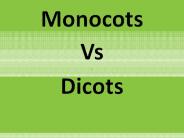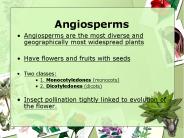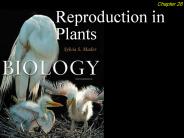Monocots PowerPoint PPT Presentations
All Time
Recommended
Monocots & Dicots Types of Angiosperms Botany Angiosperms Angiosperms are flowering plants. Angiosperms belong to the division Magnoliophyta. Angiosperms can be ...
| free to view
Monocots 25% of flowering plants (11 orders) Petaloid Monocots The cellulose synthase superfamily in rice. The CesA genes, CslA genes, and cereal-specific CslF ...
| free to download
Orchid Flowers. The Orchid World is Full of Violence, Sex & Lies! Bee orchid, Ophrys apifera. ... are in the same order as Asparagus. Liliales. Smilax ...
| free to download
Scattered vascular bundles (also in Nymphaeaceae, Piperaceae) Sieve cell plastids with several cuneate protein crystals (also in paleoherbs) Adventitious roots ...
| free to view
Monocots and Eudicots (Dicots) Comparison of Plants and Seeds Review: Classification of Plants Kingdom - Subkingdom - Division Class Order PLANTS Bryophytes (non ...
| free to download
Plants are the fundamental building blocks of life on earth. Plants are life forms belonging to the kingdom Plantae. The scientific study has revealed at least ...
| free to download
Monocots and Dicots of Mississippi The Monocots Blackberry Lily Day Lily White Trillium Mud Plantain Crested Iris The Dicots Sticktight Sunflower Flowering Dogwood ...
| free to view
Carp.: *, 7- , 0, 1; achene. staminate. pistillate. Hugh Wilson website ... Carp.: *, 3, 3, 0, 3-6; berry, fleshy capsule. From Judd et al. (2002) Limnobium ...
| free to view
Some examples are: Palms Grasses Orchids onions Characteristics of Monocots What are they? Dicotyledons (Dicots) Dicots also have special characteristics.
| free to view
Order Poales, family Bromeliaceae, Typhaceae, Eriocaulaceae, ... Andropogon gerardii. Sorghastrum nutans. Native Grass Species... Sporobolus heterolepis ...
| free to view
Figure 35.1 A comparison of monocots and dicots ... Figure 35.20 Production of secondary xylem and phloem by the vascular cambium ...
| free to view
Absolute Angiosperms. Magnoliophyta. Primitive Angiosperm Lineages. Amborella trichopoda ... Monocots vs. Eudicots. Eu- Monocots vs. Eudicots. Basal Eudicots ...
| free to download
Angiosperms The Flowering Plants Monocots Vs. Dicots Main Differences First Seed Leaves Leaf Differences - Vein Arrangement Monocots Dicots Examples Monocots ...
| free to download
Monocots (all herbs) Liliaceae Iridaceae Orchidaceae Poaceae Cyperaceae Juncaceae petaloid (showy flowers) not petaloid (reduced flowers) Monocots ...
| free to view
Angiosperms are the most diverse and geographically most widespread plants Have flowers and fruits with seeds Two classes: 1. Monocotyledones (monocots)
| free to download
Bryophyta- Non-vascular plants Dicranoweisia cirrata Tracheophyta- Vascular plants Pterophyta Coniferophyta Ginkgophyta Anthophyta Eudicots Monocots 1 2 3 4 5 Monocot ...
| free to download
Cyperaceae The Sedge Family * * 70-115 genera 3600-5000 species Herbs Monocots Annual, biennial, or perennial Flowers are arranged in spikelets somewhat as in grasses ...
| free to download
Lesson 8 Understanding Stem Anatomy Monocots vs. Dicots Way we classify plants Monocot seeds have one seed leaf, Dicots have two seed leaves. Monocots parts are in ...
| free to download
Roots, Stems, Leaves, Tissues BSC 2011L Review of difference between monocots and dicots Organization of Flowering Plants 3 vegetative organs that don t have to do ...
| free to download
... Angiosperms Class: Monocots Order: Asparagales Family: Orchidaceae Subfamily: Epidendroideae Tribe: Epidendreae Subtribe: Laeliinae Alliance: ...
| free to view
Flower produces two types of spores. Microspore - Male gametophyte. Undergoes mitosis ... In monocots, flower parts occur in threes and multiples of three ...
| free to download
Pines, firs, spruces, yews, junipers, cedars, cypress, and red woods. 550 species ... Cypress. Pine Farm. Phylum Anthophyta. Flowering Plants. Monocots and dicots ...
| free to view
Arabidopsis Thaliana Arabidopsis Mutants Effect of Environment of Plant Form Angiosperms Monocots and Dicots Comparison of Monocot and Dicot Plants Monocot and Dicot ...
| free to view
Do NOT have conducting tissue (pipes) to transport water and nutrients. ... Examples: roses, cactuses, sunflowers, peanuts. Differences between monocots and dicots ...
| free to view
Biology 172 Chapter 35 Plant Structure and Growth Genes, the Environment and Structure The Plant Body Tissue Systems Monocots vs. Dicots The Root System Fibrous and ...
| free to view
Outline Evolutionary History Alternation of Generations Nonvascular Plants Vascular Plants Seedless Seed Angiosperms Monocots and Eudicots Flowers Evolutionary ...
| free to download
4. Eudicots- the largest group Laurales Magnoliales 2. Magnoliids Piperales Canellales 3. Monocots 1. Basal Angiosperms Monocot: 1 cotyledon Dicot: 2 cotyledons ...
| free to download
Seed Plants cont. B. Angiosperms (seed container seed formed in an ovary) Division Anthophyta (flowering plants) Class Monocotyledones (monocots); one seed leaf ...
| free to view
4. Eudicots- the largest group Laurales Magnoliales 2. Magnoliids Piperales Canellales 3. Monocots 1. Basal Angiosperms Monocot: 1 cotyledon Dicot: 2 cotyledons ...
| free to download
Plant Structure and Growth. Figure 35.1 A comparison of monocots ... Palisade parenchyma. Spongy parenchyma (contains veins xylem and phloem) Lower epidermis ...
| free to view
Commelinaceae -- the spiderwort family (42-50/500-700; cosmopolitan) Monocots II Habit herbs; somewhat succulent and with mucilaginous sap; stems somewhat jointed ...
| free to download
Monocots are usually plants that live for just one year (annuals) ... Radicle - First root of seed. Radicle. SEED PARTS - DICOT. SEED PARTS - MONOCOT ...
| free to view
a ring. Taproot. Section 22-5. Comparison of. Monocots and Dicots. Go to Section: Stem types ... Cherry, soybean pod. Aggregate fruit single flower with ...
| free to view
Nectar guide. Pollinium. Pheromone mimicry. Pollinator mutualism. Parenchyma. Schlerenchyma ... In what ways do the flowers of monocots and eudicots typically differ? ...
| free to view
IB Biology Review Chapter 35: Plant Structure What are the two types of plants IB focuses on? Angiosperms Monocots / Monocotyledonous Eudicots / Dicots ...
| free to view
Calcium and Magnesium Composition of Monocots. Calcium and ... (Like gritty flour) 100% effective. Through 10 mesh screen. 50% effective. Held on 10 mesh screen ...
| free to view
Incomplete flowers = missing one or more parts. Types of Angiosperms [115] Monocots ... Flowers = multiples of 4 or 5. Leaf veins branching. Plant Tropisms ...
| free to view
Orchidaceae -- the orchid family (835/20,000-30,000; mostly tropics but also in temperate latitudes) Monocots I Habit herbs, terrestrial, often epiphytic ...
| free to download
Kingdom is subdivided into divisions, which are the ... Dicots include oaks, maples, roses, sunflowers, and most familiar plants. Monocots vs. Dicots ...
| free to view
Linum usitatissimum, seedling. from root over hypocotyl to primary stem ... Seedling of Monocots. Transverse and longitudinal section. of a monocotyledonous plant ...
| free to view
Plant Structure and Growth Chapter 35 Plants with vascular tissue have 3 structures - roots, shoots, leaves. 2 groups of angiosperms, monocots and dicots, differ in ...
| free to download
MONOCOTS NAMED FOR A SINGLE COTYLEDON. ORCHIDS, BAMBOO, PALM, LILIES, YUCCA, GRASSES, WHEAT, ... ADVENTITIOUS ROOTS ROOT SYSTEMS ABOVE GROUND. SHOOT SYSTEMS ...
| free to view
Roots, Stems, Leaves, Tissues BSC 2011L Review of difference between monocots and dicots Organization of Flowering Plants 3 vegetative organs that don t have to do ...
| free to view
... monocots and dicots, angiosperms and gymnosperms, and vascular ... 2. Which process is prevented from occurring when stamens are removed from an angiosperm? ...
| free to view
Angiosperms flowering plants (largest phylum of living plants) Monocots flowering plants that have a single ... Stamens pollen bearing part of a flower ...
| free to view
Generally, the root system is at least equivalent in size and extent to the shoot system ... Flowering Plants: Monocots or Eudicots. Plant Tissues. Epidermal Tissues ...
| free to download
Figure 29.6 Alternation of generations: a generalized scheme ... Figure 30.17 The life cycle of an angiosperm. Figure 35.1 A comparison of monocots and dicots ...
| free to view
Insects Bats Birds. Seed. Ovary. Dicots and Monocots. Almost ... 40 seed per fruit. 8 10 lbs per person. Wheat. Coffee. Sugarcane. in-text, p. 419. HYOCYAMUS ...
| free to view
Angiosperms (Flowering Plants) A. Monocots. B. ... (Flowering Plants) ... The flower serves as a lure for insects that transfer pollen from anther to stigma. ...
| free to view
Flowering plants, branched veins, 4/5 petals. Monocots (Angiosperms) ... If both male and female parts are on the same plant (but different flowers) ...
| free to view
Flowers. seeds. PLANTS. PRIMITIVE PLANTS. MOSSES. Small, no true ... Flowering plants. Most numerous type of plants. Divided into two classes. Monocots. Corn ...
| free to view
Highly adaptable (more so than animals) to the environmental ... Two main groups of flowering plants. Monocots and Dicots. Roots, Stems, and Leaves. Root System ...
| free to view
3. The root apical meristem and the shoot apical meristem both give rise to the ... 4. Vascular bundles are arranged differently in the stems of monocots and dicots. ...
| free to view
Flowering Plants: Monocot versus Dicots 8-28-12 Plantae Kingdom Plants have: Cells Cell walls made of cellulose Chloroplasts which contain chlorophyll Roots, Leaves ...
| free to download
Arguably the most diverse major extant plant group 260,000 living species 453 Families ... insects bats and birds 90% of existing species are flowering ...
| free to download
























































